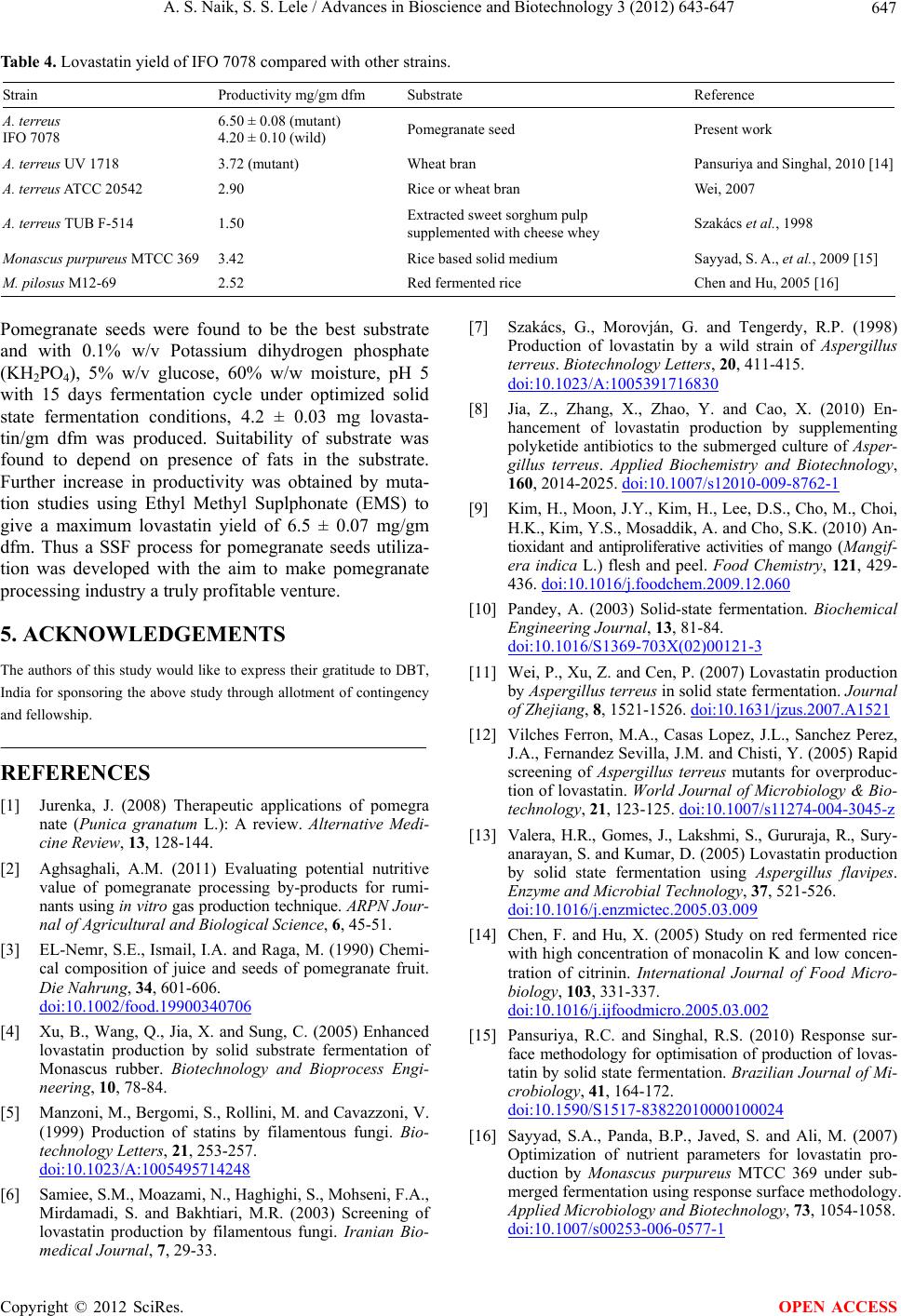
A. S. Naik, S. S. Lele / Advances in Bioscience and Biotechnology 3 (2012) 643-647
Copyright © 2012 SciRes.
647
Table 4. Lovastatin yield of IFO 7078 compared with other strains.
Strain Productivity mg/gm dfm Substrate Reference
A. terreus
IFO 7078 6.50 ± 0.08 (mutant)
4.20 ± 0.10 (wild) Pomegranate seed Present work
A. terreus UV 1718 3.72 (mutant) Wheat bran Pansuriya and Singhal, 2010 [14]
A. terreus ATCC 20542 2.90 Rice or wheat bran Wei, 2007
A. terreus TUB F-514 1.50 Extracted sweet sorghum pulp
supplemented with cheese whey Szakács et al., 1998
Monascus purpureus MTCC 369 3.42 Rice based solid medium Sayyad, S. A., et al., 2009 [15]
M. pilosus M12-69 2.52 Red fermented rice Chen and Hu, 2005 [16]
[7] Szakács, G., Morovján, G. and Tengerdy, R.P. (1998)
Production of lovastatin by a wild strain of Aspergillus
terreus. Biotechnology Letters, 20, 411-415.
doi:10.1023/A:1005391716830
Pomegranate seeds were found to be the best substrate
and with 0.1% w/v Potassium dihydrogen phosphate
(KH2PO4), 5% w/v glucose, 60% w/w moisture, pH 5
with 15 days fermentation cycle under optimized solid
state fermentation conditions, 4.2 ± 0.03 mg lovasta-
tin/gm dfm was produced. Suitability of substrate was
found to depend on presence of fats in the substrate.
Further increase in productivity was obtained by muta-
tion studies using Ethyl Methyl Suplphonate (EMS) to
give a maximum lovastatin yield of 6.5 ± 0.07 mg/gm
dfm. Thus a SSF process for pomegranate seeds utiliza-
tion was developed with the aim to make pomegranate
processing industry a truly profitable venture.
[8] Jia, Z., Zhang, X., Zhao, Y. and Cao, X. (2010) En-
hancement of lovastatin production by supplementing
polyketide antibiotics to the submerged culture of Asper-
gillus terreus. Applied Biochemistry and Biotechnology,
160, 2014-2025. doi:10.1007/s12010-009-8762-1
[9] Kim, H., Moon, J.Y., Kim, H., Lee, D.S., Cho, M., Choi,
H.K., Kim, Y.S., Mosaddik, A. and Cho, S.K. (2010) An-
tioxidant and antiproliferative activities of mango (Mangif-
era indica L.) flesh and peel. Food Chemistry, 12 1, 429-
436. doi:10.1016/j.foodchem.2009.12.060
[10] Pandey, A. (2003) Solid-state fermentation. Biochemical
Engineering Journal, 13, 81-84.
doi:10.1016/S1369-703X(02)00121-3
5. ACKNOWLEDGEMENTS
The authors of this study would like to express their gratitude to DBT,
India for sponsoring the above study through allotment of contingency
and fellowship.
[11] Wei, P., Xu, Z. and Cen, P. (2007) Lovastatin production
by Aspergillus terreus in solid state fermentation. Journal
of Zhejiang, 8, 1521-1526. doi:10.1631/jzus.2007.A1521
[12] Vilches Ferron, M.A., Casas Lopez, J.L., Sanchez Perez,
J.A., Fernandez Sevilla, J.M. and Chisti, Y. (2005) Rapid
screening of Aspergillus terreus mutants for overproduc-
tion of lovastatin. World Journal of Microbiology & Bio-
technology, 21, 123-125. doi:10.1007/s11274-004-3045-z
REFERENCES
[1] Jurenka, J. (2008) Therapeutic applications of pomegra
nate (Punica granatum L.): A review. Alternative Medi-
cine Review, 13, 128-144. [13] Valera, H.R., Gomes, J., Lakshmi, S., Gururaja, R., Sury-
anarayan, S. and Kumar, D. (2005) Lovastatin production
by solid state fermentation using Aspergillus flavipes.
Enzyme and Microbial Technology, 37, 521-526.
doi:10.1016/j.enzmictec.2005.03.009
[2] Aghsaghali, A.M. (2011) Evaluating potential nutritive
value of pomegranate processing by-products for rumi-
nants using in vitro gas productio n technique. ARPN Jou r-
nal of Agricultural and Biological Science, 6, 45-51. [14] Chen, F. and Hu, X. (2005) Study on red fermented rice
with high concentration of monacolin K and low concen-
tration of citrinin. International Journal of Food Micro-
biology, 103, 331-337.
doi:10.1016/j.ijfoodmicro.2005.03.002
[3] EL-Nemr, S.E., Ismail, I.A. and Raga, M. (1990) Chemi-
cal composition of juice and seeds of pomegranate fruit.
Die Nahrung, 34, 601-606.
doi:10.1002/food.19900340706
[4] Xu, B., Wang, Q., Jia, X. and Sung, C. (2005) Enhanced
lovastatin production by solid substrate fermentation of
Monascus rubber. Biotechnology and Bioprocess Engi-
neering, 10, 78-84.
[15] Pansuriya, R.C. and Singhal, R.S. (2010) Response sur-
face methodology for optimisation of production of lovas-
tatin by solid state fermentation. Brazilian Journal of Mi-
crobiology, 41, 164-172.
doi:10.1590/S1517-83822010000100024
[5] Manzoni, M., Bergomi, S., Rollini, M. and Cavazzoni, V.
(1999) Production of statins by filamentous fungi. Bio-
technology Letters, 21, 253-257.
doi:10.1023/A:1005495714248
[16] Sayyad, S.A., Panda, B.P., Javed, S. and Ali, M. (2007)
Optimization of nutrient parameters for lovastatin pro-
duction by Monascus purpureus MTCC 369 under sub-
merged fermentation using response surface methodology.
Applied Microbiology and Biotechnology, 73, 1054-1058.
doi:10.1007/s00253-006-0577-1
[6] Samiee, S.M., Moazami, N., Haghighi, S., Mohseni, F.A.,
Mirdamadi, S. and Bakhtiari, M.R. (2003) Screening of
lovastatin production by filamentous fungi. Iranian Bio-
medical Journal, 7, 29-33.
OPEN ACCESS